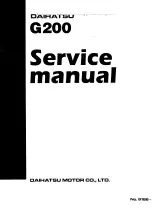
07 Wheels and tires
Tire inflation
07
``
177
Inflation placard
G032513
Tire inflation placard
Check tire inflation pressure regularly.
Tables listing the recommended inflation pres-
sure for your vehicle can be found beginning
on page 179. A tire inflation pressure placard
is also located on the driver's side B-pillar (the
structural member at the side of the vehicle, at
the rear of the driver's door opening). This plac-
ard indicates the designation of the factory-
mounted tires on your vehicle, as well as load
limits and inflation pressure.
NOTE
The placards shown indicate inflation pres-
sure for the tires installed on the car at the
factory only.
Use a tire gauge to check the tire inflation pres-
sure, including the spare, at least once a month
and before long trips. You are strongly urged
to buy a reliable tire pressure gauge, as auto-
matic service station gauges may be inaccu-
rate.
Use the recommended cold inflation pressure
for optimum tire performance and wear.
Under-inflation or over-inflation may cause
uneven treadwear patterns.
WARNING
•
Under-inflation is the most common
cause of tire failure and may result in
severe tire cracking, tread separation,
or "blowout," with unexpected loss of
vehicle control and increased risk of
injury.
•
Under-inflated tires reduce the load car-
rying capacity of your vehicle.
When weather temperature changes occur, tire
inflation pressures also change. A 10-degree
temperature drop causes a corresponding
drop of 1 psi (7 kPa) in inflation pressure. Check
your tire pressures frequently and adjust them
to the proper pressure, which can be found on
the vehicle's tire information placard or certifi-
cation label.
Checking tire pressure
Cold tires
Inflation pressure should be checked when the
tires are cold.
The tires are considered to be cold when
they have the same temperature as the sur-
rounding (ambient) air.
This temperature is normally reached after the
car has been parked for at least 3 hours.
After driving a distance of approximately 1 mile
(1.6 km), the tires are considered to be hot. If
you have to drive farther than this distance to
pump your tire(s), check and record the tire
pressure first and add the appropriate air pres-
sure when you get to the pump.
If checking tire pressure when the tire is hot,
never "bleed" or reduce air pressure. The tires
are hot from driving and it is normal for pres-
sures to increase above recommended cold
pressures. A hot tire at or below recommended
cold inflation pressure could be significantly
under-inflated.
Summary of Contents for S40 2011
Page 1: ...VOLVO V50 Owner s Manual Web Edition ...
Page 2: ......
Page 8: ...Contents 8 12 12 Index Index 282 ...
Page 9: ...Contents 9 ...
Page 17: ...SAFETY ...
Page 51: ...INSTRUMENTS AND CONTROLS ...
Page 52: ...02 Instruments and controls Instrument overview 02 52 G019488 ...
Page 91: ...CLIMATE ...
Page 103: ...INTERIOR ...
Page 111: ...04 Interior Storage compartments 04 111 ...
Page 121: ...LOCKS AND ALARM ...
Page 137: ...STARTING AND DRIVING ...
Page 171: ...06 Starting and driving 06 171 ...
Page 173: ...WHEELS AND TIRES ...
Page 202: ...202 Washing and cleaning the car 204 Paint touch up 208 ...
Page 203: ...CAR CARE ...
Page 209: ...08 Car care 08 209 ...
Page 211: ...MAINTENANCE AND SERVICING ...
Page 239: ...AUDIO ...
Page 263: ...10 Audio 10 263 ...
Page 265: ...SPECIFICATIONS ...
Page 266: ...11 Specifications Label information 11 266 ...
Page 281: ...11 Specifications 11 281 ...
Page 290: ...12 Index 12 290 ...
Page 291: ......
Page 292: ...Kdakd 8Vg 8dgedgVi dc IE JH6 8VcVYV 6I Eg ciZY c HlZYZc iZWdg 8deng i Kdakd 8Vg 8dgedgVi dc ...
















































